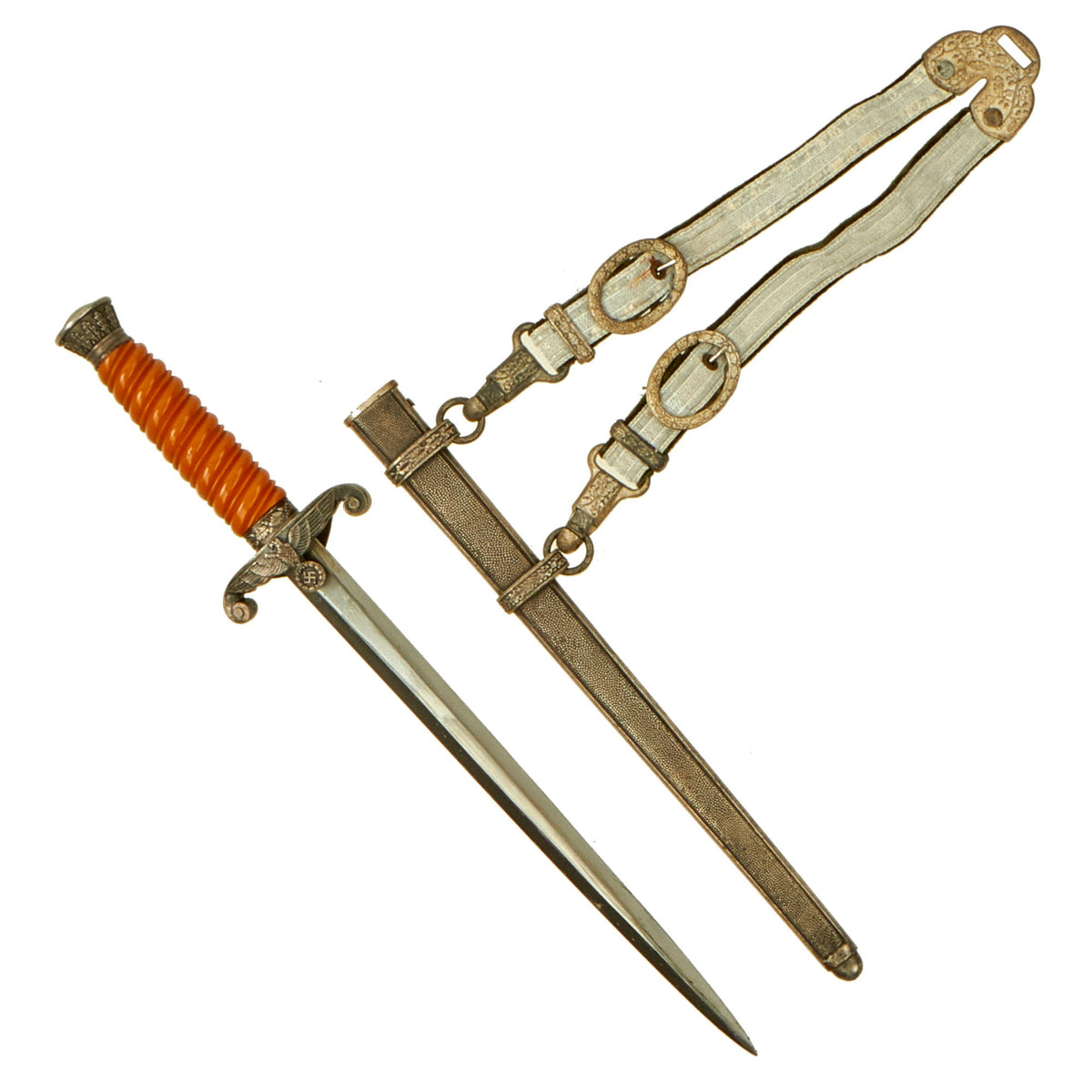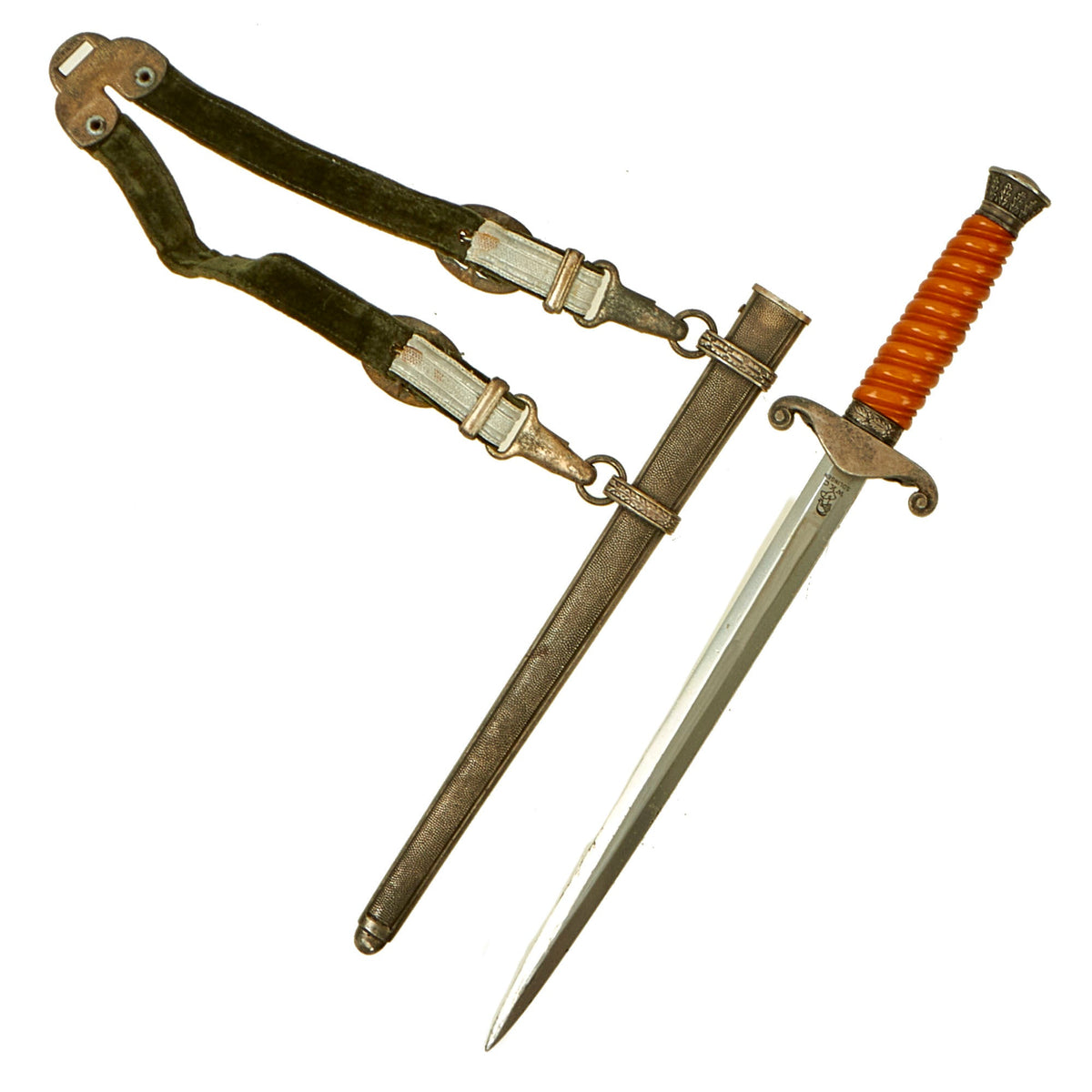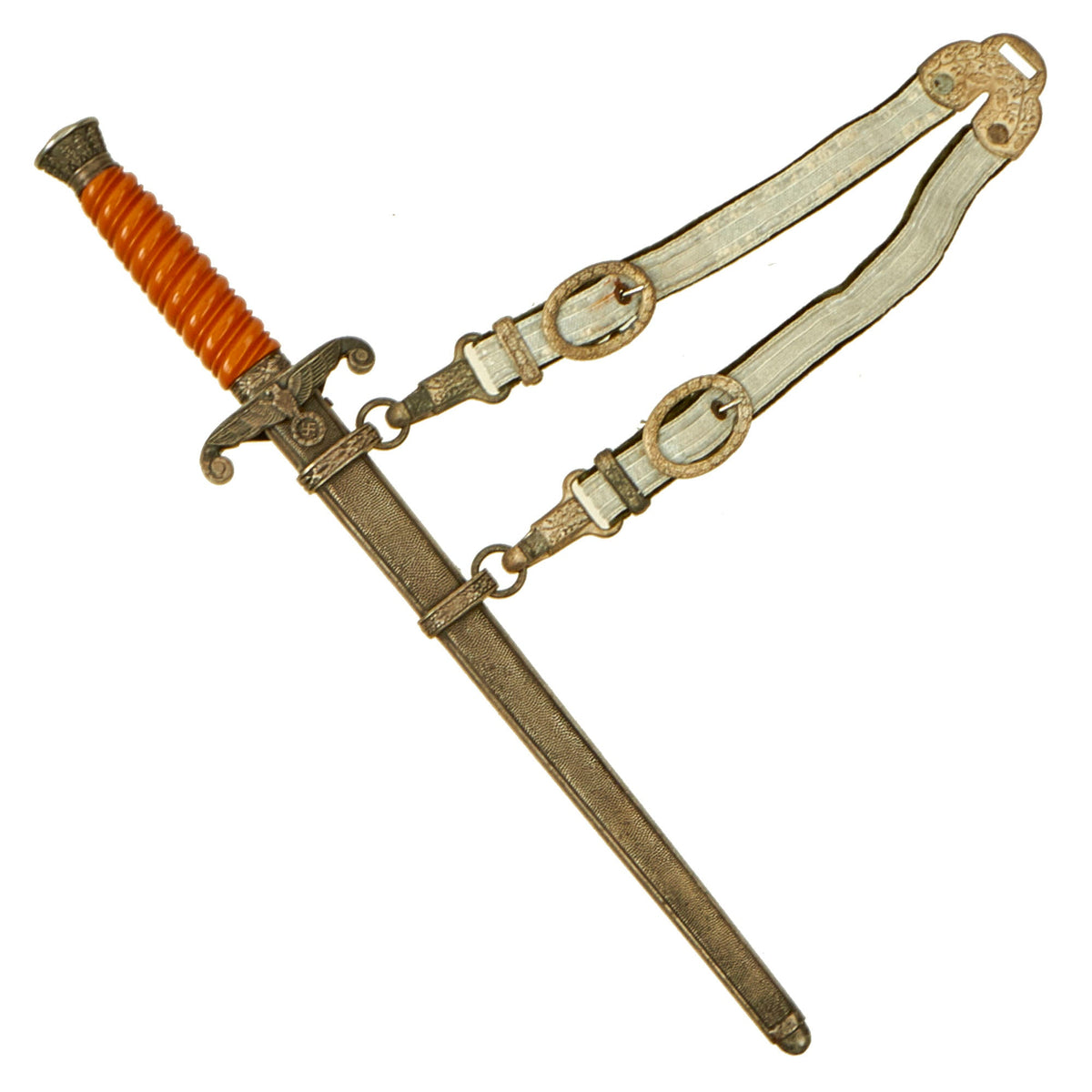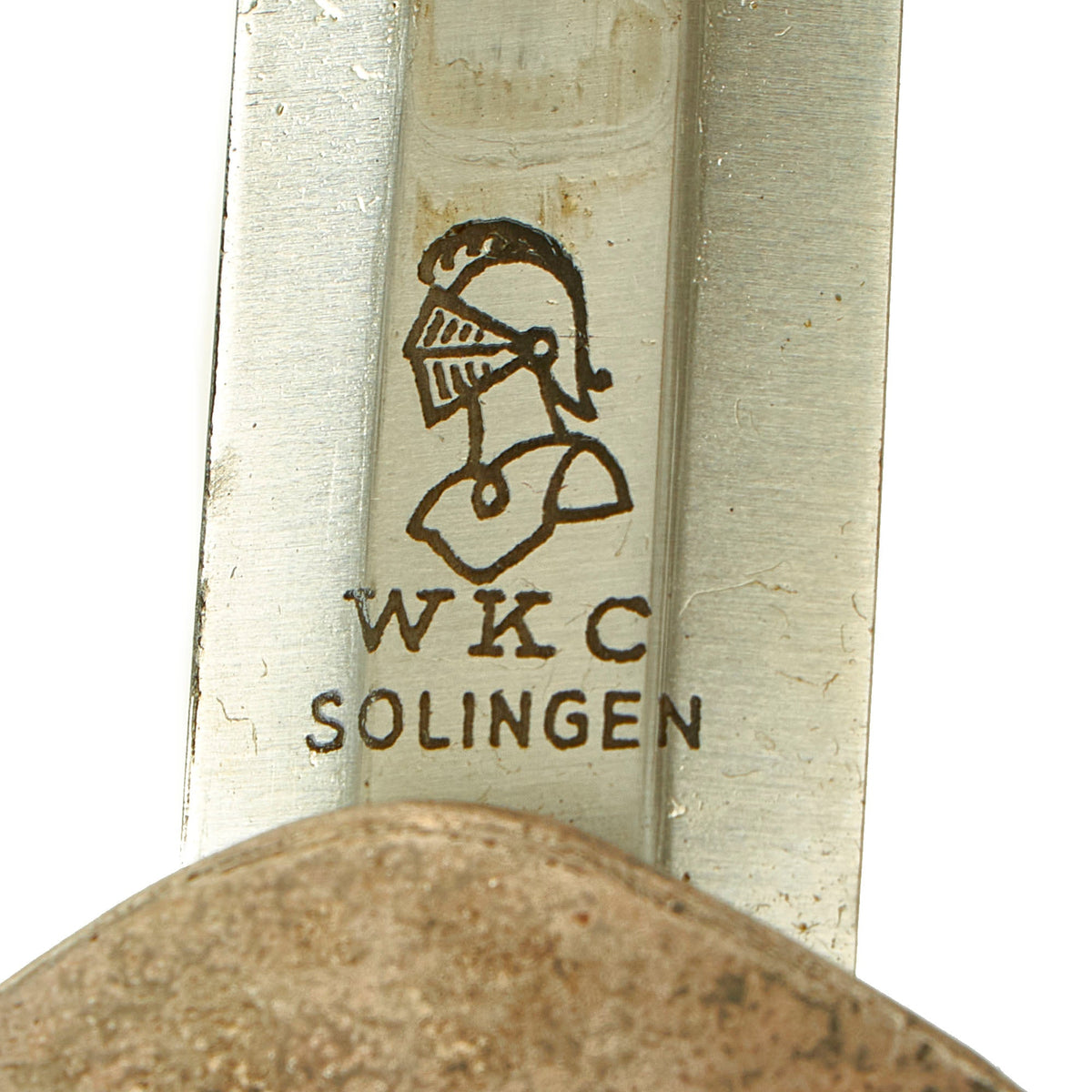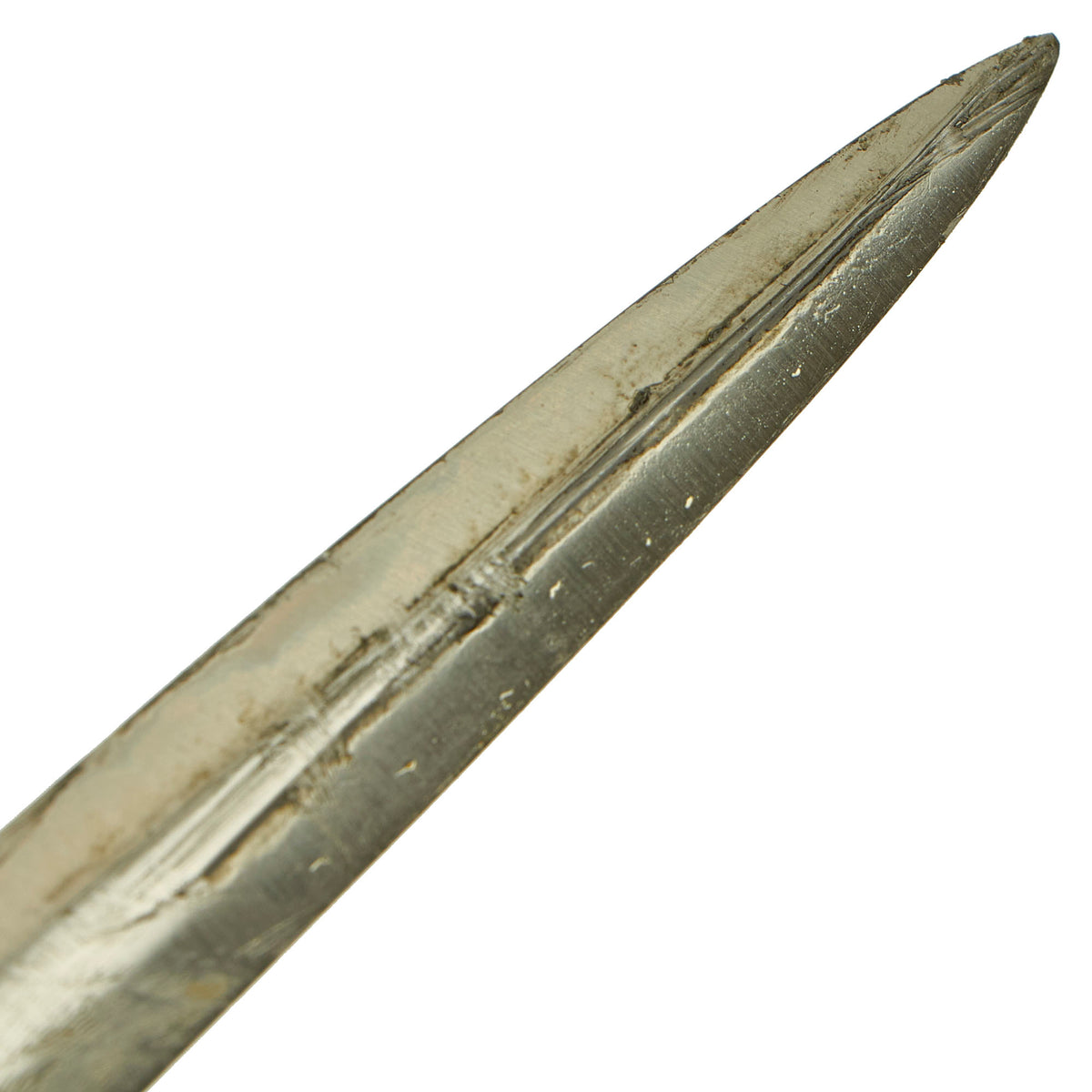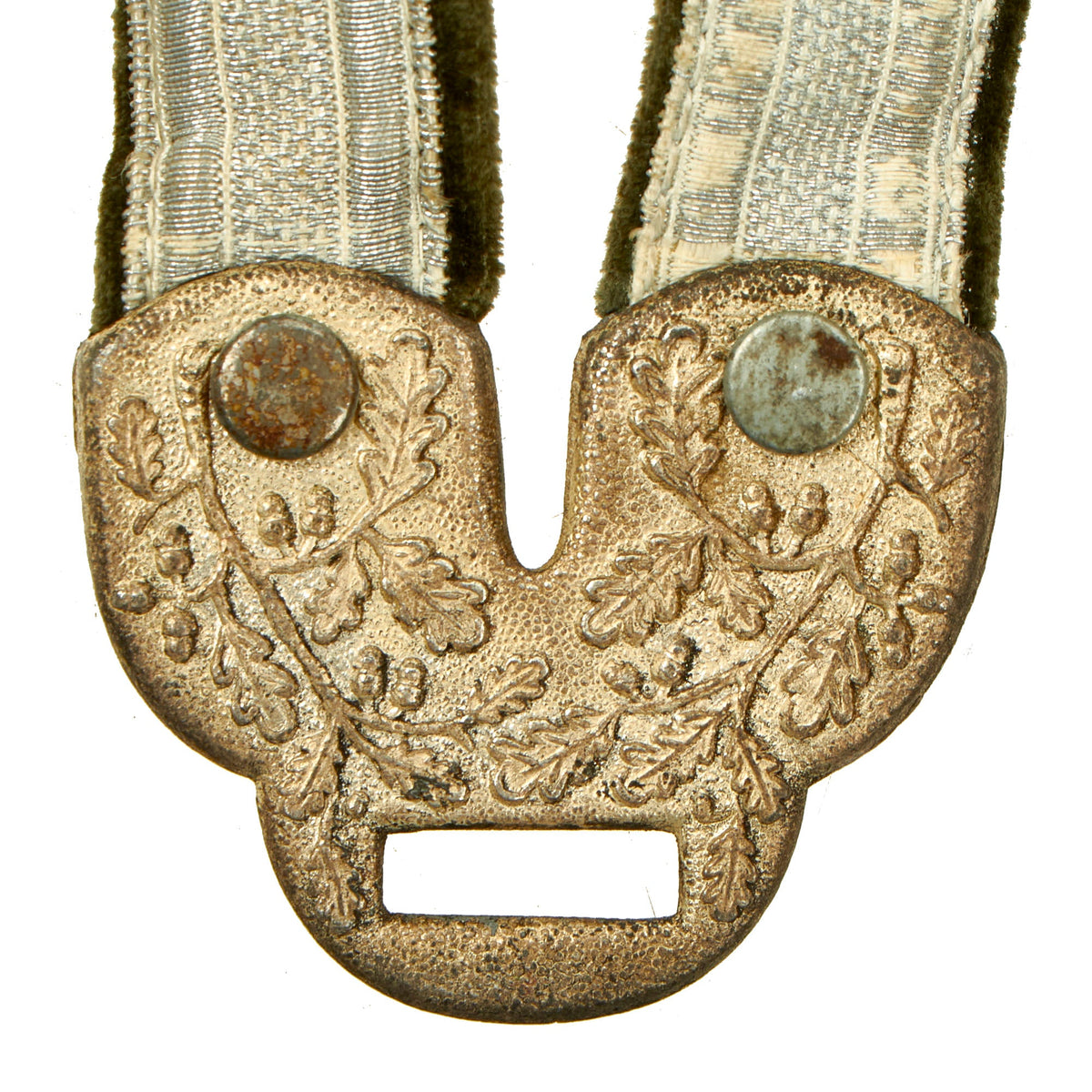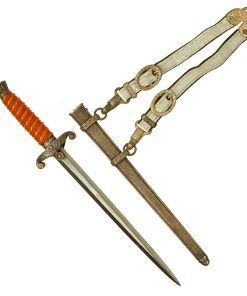Original Excellent German WWII Heer Army Officer Dagger by W.K.C. Waffenfabrik of Solingen with Scabbard & Hanger Original Items
$ 895,00 $ 223,75
Original Item: Only One Available. This is an excellent wartime production Army Officer’s Dagger, produced by the legendary Solingen-based firm of W.K.C. Waffenfabrik GmbH, a highly desirable maker of edged weapons. The zinc alloy pommel of this dagger is in very nice condition, showing light wear and oxidation overall, with the original plating still well retained but patinated. The standing oak leaves and acorns are crisply detailed and show some oxidized remnants of the original plating.
The zinc alloy cross guard is in similar condition, with a lovely oxidized patina on the plating, and a great look. The details throughout the characteristic WKC eagle are still present throughout the head, breast and wing feathering, talons and wreathed mobile swas (hook cross). The leather blade buffer is still present in the recess on top of the guard. The grip is a great caramel orange color, aged from the original ivory white. This grip is in very good condition, with no cracks or other major issues that we can see. The steel grip ferrule is also silver-plated, and now shows a tarnished patina. The hilt is still tight on the tang of the blade.
The excellent condition blade is bright throughout, showing the original cross grain throughout the blade surface. This texture is iconic, and is the definitive identifying characteristic for a real WWII German Blade. The needle-like tip is intact and unbent, and the edges have correctly not been sharpened. There is the usual runner wear on the blade surface, however this is present on just about every dagger out there. This is definitely one of the best German dagger blades that we have ever seen!
The reverse ricasso is etched with the trademark “Knights-Head” (Ritter-helm) logo of legendary maker Weyersberg Kirschbaum & Cie of Solingen, over the firms initials of WKC / SOLINGEN. This company is a famous manufacturer of military swords and cutlery in Solingen, Germany – a city famous since the middle ages for its metal-working and craftsmanship in sword making. Per J. Anthony Carter’s fine work GERMAN SWORD AND KNIFE MAKERS, the traditional manufacturing of swords at WKC dates back to the year 1774 when the Weyersberg first registered the ”Kings head” as their trademark. Later in 1883 the company merged with the Kirschbaums and the company Weyersberg Kirschbaum & Cie was formed, which continued into the Weimar Period. It then rebranded as W.K.C. Waffenfabrik GmbH, and produced many edged weapons during the NSDAP Period. The company is still in operation today.
The scabbard is a classic WKC example, and looks to originally have been silver plated, which has turned a lovely gray color over the years, while areas where the plating wore through display an oxidized patina. This scabbard does not have any dents we can see, and it still has crisp finely grained panels. The carrying bands have an excellent pattern of overlapping oak leaves and acorns, with hand enhancing evident on each of the leaves, though they do show some moderate oxidation.
Attached to the scabbard is a very good condition belt hanger, with functional pebbled spring clips with a great patina. The buckles and keepers are engraved with the same oak and acorn motif seen throughout the dagger. The clips are the more desirable “sliding” type, both marked D.R.G.M. on the back, indicating it is a trademarked design. The original silver wash is still mostly present, still bright in a lot of places. The straps are in very good condition, with the velvet on the back well retained, and the silver bullion front side showing some wear and oxidation. The end clip is definitely interesting, and is not a style we often encounter.
An excellent Heer Army Dagger from a legendary maker, complete with scabbard and hanger. Ready to display!
Specifications:
Blade Length: 9 1/2″
Blade Style: Spear Point Dagger
Overall length: 14“
Crossguard: 2 3/4”
Scabbard Length: 11 1/8″
The German Army (Heer) first carried a dagger beginning in 1935. The weapon was worn in lieu of occasions not demanding the wearing of a more formal sword. The dagger design was quite attractive featuring silvered heavy fittings with white or colored grip. The crossguard depicted a Wehrmacht open-winged eagle clutching a wreathed swas.
The pommel depicted oak leafing around the outer circumference. The scabbard had panels of pebble designs. Later produced examples were plated with nickel, and late war-made pieces were unplated, finished in a gray color metal. These daggers are often encountered with an aluminum portepee.
Fast Shipping with Professional Packaging
Thanks to our longstanding association with UPS FedEx DHL, and other major international carriers, we are able to provide a range of shipping options. Our warehouse staff is expertly trained and will wrap your products according to our exact and precise specifications. Prior to shipping, your goods will be thoroughly examined and securely secured. We ship to thousands clients each day across multiple countries. This shows how we're dedicated to be the largest retailer on the internet. Warehouses and distribution centres can be located throughout Europe as well as the USA.
Note: Orders with more than one item will be assigned a processing date depending on the item.
Before shipping before shipping, we'll conduct a thorough inspection of the items you have ordered. Today, the majority of orders will be delivered within 48 hours. The delivery time will be between 3-7 days.
Returns
The stock is dynamic and we cannot completely manage it because multiple stakeholders are involved, including our factory and warehouse. So the actual stock may alter at any time. It's possible that you may not receive your order once the order has been made.
Our policy is valid for a period of 30 days. If you don't receive the product within 30 days, we are not able to issue a refund or an exchange.
You can only return an item if it is unused and in the same state as the day you received it. You must have the item in its original packaging.
Related products
Uncategorized
Uncategorized
Uncategorized
Uncategorized
Armoured Fighting Vehicles of the World: AFVs of World War One (Hardcover Book) New Made Items
Uncategorized
Uncategorized
Uncategorized
Australian WWII Owen MK1 Machine Carbine SMG Custom Fabricated Replica with Sling Original Items
Uncategorized
Uncategorized
Uncategorized
Uncategorized
Uncategorized
Uncategorized
Uncategorized
Uncategorized
Uncategorized
Band of Brothers ORIGINAL GERMAN WWII Le. F.H. 18 10.5cm ARTILLERY PIECE Original Items
Uncategorized
